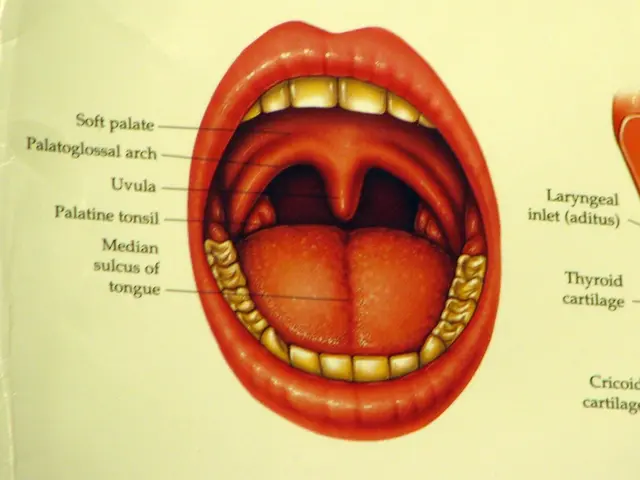Connection between Breast and Ovarian Cancer: Association and Risk Factors
Busting the Link Between Breasts and Ovaries: A Deep Dive into Breast and Ovarian Cancer Shared Genetic Factors
There's no beating around the bush: breast and ovarian cancers are tightly linked, primarily due to shared genetic mutations. If you've got a family history of one, chances are you've got a higher risk for the other. But why is that, you ask? Let's dive in.
The Six-Degrees of Genetic Separation
Breast and ovarian cancers share several risk factors, both inherited and acquired, that make each type of cancer a ticking time bomb for some individuals. Among the most potent of these shared genetic risk factors are the BRCA1 and BRCA2 genes.
These genes play a crucial role in repairing damaged DNA. When they're mutated, cells are more prone to accumulating further mutations, increasing the odds of cancer development. According to , as many as 10-15% of all breast and ovarian cancers are due to inherited mutations in these genes.
It Runs in the Family
If breast or ovarian cancer has shown up in your family tree, it could mean more trouble down the road. Just like inherited mutations in the BRCA genes, other inherited mutations can pave the way for cancer – think Lynch syndrome or hereditary diffuse gastric cancer syndrome.
Your Personal Cancer Risk
If you've had breast cancer, you might be at risk for ovarian cancer and vice versa, thanks to overlapping genetic and reproductive risk factors.
Age plays a significant role, with the risk for both breast and ovarian cancers increasing as you get older (most breast cancers occur in women over 50, and most ovarian cancers in women over 60).
Reproductive history can also be a risk factor. Don't have kids? Had your first child after 35? You're at a higher risk. And hormones? Exposure to estrogen and other hormones can increase your chances of developing breast and ovarian cancers.
Lifestyle Factors: Simplifying the Math
Science hasn't quite figured out exactly why, but obesity and certain dietary habits can increase the risk for both breast and ovarian cancers.
Exploring the BRCA-Risk Landscape
Women with BRCA1 or BRCA2 mutations face a significantly higher risk of developing breast cancer, with a lifetime risk of up to 72% for BRCA1 and up to 69% for BRCA2 carriers.
Ovarian cancer risk is also astronomical, with lifetime risks estimated at 39–44% for BRCA1 and 11–17% for BRCA2 carriers. Men are also in the crosshairs, with BRCA carriers facing an up-to 1.2% risk for breast cancer and a tiny 7% risk for prostate cancer.
Protecting Yourself: Prevention and Screening Methods
Early detection through regular screenings is key for those at high risk. Depending on your risk level, preventive measures such as prophylactic surgeries or medications may be recommended.
Spilling the Tea on Other Risks
BRCA mutations can also up the ante for other cancers, depending on the specific gene mutation and family history. Cancers such as colorectal, melanoma, and pancreatic cancers can also raise their ugly heads as a result of these genetic mutations.
Takeaway: Knowledge is Power
Armed with this knowledge, you can take charge of your health. If you have a family history of breast or ovarian cancer, talk to your doctor about genetic testing and potentially preventive measures. And remember, early detection can make all the difference.
Sources:- U.S. National Library of Medicine. (2021). GeneReviews® - BRCA1 and BRCA2: Cancer Susceptibility. Retrieved from- National Cancer Institute. (2017). What You Need To Know About Ovarian Cancer: Risk Factors. Retrieved from- American Cancer Society. (2018). What Are the Risk Factors for Breast Cancer? Retrieved from- National Cancer Institute. (2021). Genetic Testing for Breast and Ovarian Cancer Susceptibility. Retrieved from- T.C. Kent, R.S. Brooks-Wilson, A. Klijn, et al. (2021). Assessing BRCA1 and BRCA2 in Breast and Ovarian Cancer Patients in Sub-Saharan Africa: Systematic Review and Meta-Analysis. Genes, 12(4), 480. doi: 10.3390/genes12040480.- K.M. Osborne, S.S. Gileadi, J.L. Kilmarx, et al. (2021). Incidence and survival trends in ovarian cancer subtypes in the National Cancer Database, 2004-2015. Gynecologic Oncology, 164, 293-300. doi: 10.1016/j.ygyno.2020.09.023.
- The shared genetic mutations between breast and ovarian cancers, such as the BRCA1 and BRCA2 genes, play a crucial role in the development of these cancers.
- If breast or ovarian cancer has appeared in a family's medical history, this can increase the risk for other individuals in the family.
- Age, reproductive history, lifestyle factors like obesity and diet, and hormone exposure can also contribute to the risk of developing both breast and ovarian cancers.
- Women with BRCA1 or BRCA2 mutations have a significantly higher risk of developing breast cancer and, although to a lesser extent, ovarian cancer, as well as an increased risk for other cancers such as colorectal, melanoma, and pancreatic cancers.
- Early detection through regular screenings, and potentially preventive measures like prophylactic surgeries or medications, can be crucial for individuals at high risk of breast and ovarian cancers based on their genetic profile and family history.








